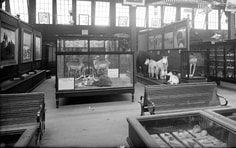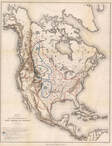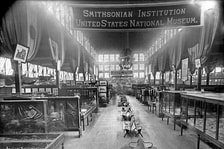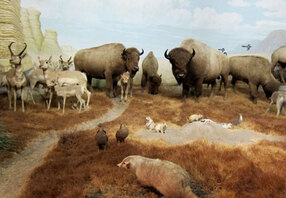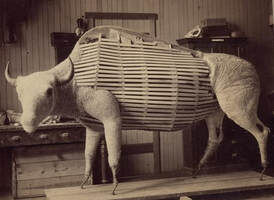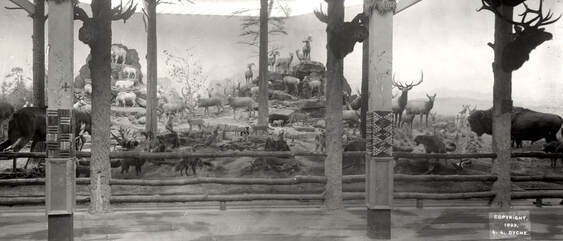EXTENDED USES OF HORNADAY
BISON SPECIMENS FROM THE
1886 HUNT FOR BUFFALO
BISON SPECIMENS FROM THE
1886 HUNT FOR BUFFALO
THE EXTERMINATION SERIES
1888 Centennial Exposition of the Ohio Valley and Central States, Cincinnati, Ohio
1888 Centennial Exposition of the Ohio Valley and Central States, Cincinnati, Ohio
In the winter of 1886, during the Smithsonian Institution's Hunt for Buffalo, William Temple Hornaday and company witnessed firsthand an immense carnage. As Hornaday later reported,
|
...we were seldom out of sight of bleaching skeletons, and often 40 or 50 were in sight at one time...Like ghastly monuments of slaughter, these ugly excrescences stand out in bold relief on the smooth, hard surface of the prairie...They lie today precisely as they fell...except that the flesh is no longer upon them...The bones are still held together by a few dried-up ligaments, but are bleached white as snow... [Heads are left unskinned] and the thick hide has dried down upon the skulls harder than the bone itself, holding the tangled masses of the shaggy frontlet firmly in place until it bleaches brown and is finally worn away by wind and weather. Many of these heads are so perfectly preserved...that the slaughter of the millions is brought right down to the present...
|
This experience -- in a still-remote part of eastern Montana -- transformed William Hornaday; it provided an impetus for his work, later in life, as a founder of the American Conservation movement.
Returning from his Hunt for Buffalo, William Hornaday got to work on another of his major missions as naturalist, scientific collector and budding-conservationist. Resuming his public role as Chief Taxidermist with the National Museum of Natural History in Washington, D.C., Hornaday felt compelled to inform Americans of the immense slaughter of bison and all wildlife then culminating across their western territories.
He and his Smithsonian team immediately set to work preparing six of his finest bison specimens for his American Bison Group. But, somehow, Hornaday also found time and determination to create a dramatic display of the carnage he saw unfolding in the west, mere months earlier, during his buffalo expedition. Hornaday's "Extermination Series" display appeared in 1888, as part of the larger Exhibit of the Smithsonian Institution, erected in the Park Building of the Cincinnati 'Expo.' Here, millions of visitors bore witness to the immense slaughter of wild animals then occurring across the American Great Plains and prairies. In Hornaday's own words and works, visitors caught a tangible inkling of the grotesque scale of that carnage.
As the official guidebook to the 1888 Expo reports of the Extermination Series,
Returning from his Hunt for Buffalo, William Hornaday got to work on another of his major missions as naturalist, scientific collector and budding-conservationist. Resuming his public role as Chief Taxidermist with the National Museum of Natural History in Washington, D.C., Hornaday felt compelled to inform Americans of the immense slaughter of bison and all wildlife then culminating across their western territories.
He and his Smithsonian team immediately set to work preparing six of his finest bison specimens for his American Bison Group. But, somehow, Hornaday also found time and determination to create a dramatic display of the carnage he saw unfolding in the west, mere months earlier, during his buffalo expedition. Hornaday's "Extermination Series" display appeared in 1888, as part of the larger Exhibit of the Smithsonian Institution, erected in the Park Building of the Cincinnati 'Expo.' Here, millions of visitors bore witness to the immense slaughter of wild animals then occurring across the American Great Plains and prairies. In Hornaday's own words and works, visitors caught a tangible inkling of the grotesque scale of that carnage.
As the official guidebook to the 1888 Expo reports of the Extermination Series,
|
In this exhibit is shown specimens of all of the larger mammals which are rapidly disappearing from the country. It includes the bison, antelope, elk, moose, mountain goat, mountain sheep and the seal. The bison or American buffalo is the object of special attention, and the methods employed in its destruction are fully shown in a series of pictures. Several grades of buffalo hides are exhibited, and a map shows by colored areas the narrowing range of this animal from time to time. In the rear is a case of pelts of the mountain goat and a complete collection of the various kinds of guns used in the slaughter of animals.
|
In a photograph of the exhibition (access below) one sees the desiccating carcass of a buffalo -- brought by Hornaday from his buffalo expedition -- stretched lifeless as it had fallen, months earlier, upon its native sod. At lower left in the photo, a caption by Hornaday tells the larger story:
|
THE FATE OF THE AMERICAN BISON
FROM THE GREAT NORTHERN BUFFALO RANGE In a few remote locations in Montana and Texas, where the wagons of the bone-pickers have not yet gone, thousands of bleaching skeletons such as this are still to be seen, just as they fell before the leaden hail of the hide-hunters. As many as fifty are often in sight at one time, some with the hide still on them. On these treeless prairies, these ghastly relics of a merciless slaughter are the most conspicuous objects to be seen, and they impart to the landscape an element of lifeless desolation which is undeniable. In some localities we rode ahead many miles in any direction, without ever being out of sight of bleaching skeletons of the Buffalo.
Over the greater portion of the Buffalo Ranges, all the bones have been carefully gathered up, shipped East, and sold by the ton for the agreed price. This business is rapidly emptying the entire range of the Bison, and in a very few years not even a bleaching bone will remain above ground to tell the story of the millions that have been utterly destroyed by the senseless, heartless, and wasteful greed of man. |
Also included in the Extermination Series at the Cincinnati Expo was a U.S. map depicting the declining range of wild American bison over time. The historic map was produced by the Smithsonian from data painstakingly gathered by Hornaday. The map later appeared as an endpaper in Hornaday's memoir, "The Extermination of the American Bison" (U.S. Government Printing Office, 1889).
View exhibition photographs, and related documents and information, at the following sources:
THE PHOTO:
https://siarchives.si.edu/blog/reconstructing-william-temple-hornaday-1888-extermination-series
THE MAP: https://digital.library.cornell.edu/catalog/ss:3293847
EXPO GUIDE: https://archive.org/details/officialguideofc02cinc/page/70/mode/2up
BLOG POST 1: https://siarchives.si.edu/blog/re-mounting-american-bison
BLOG POST 2: https://siarchives.si.edu/blog/bison-lost-bison-found
View exhibition photographs, and related documents and information, at the following sources:
THE PHOTO:
https://siarchives.si.edu/blog/reconstructing-william-temple-hornaday-1888-extermination-series
THE MAP: https://digital.library.cornell.edu/catalog/ss:3293847
EXPO GUIDE: https://archive.org/details/officialguideofc02cinc/page/70/mode/2up
BLOG POST 1: https://siarchives.si.edu/blog/re-mounting-american-bison
BLOG POST 2: https://siarchives.si.edu/blog/bison-lost-bison-found
THE PANORAMA OF NORTH AMERICAN WILDLIFE
1893 World's Columbian Exposition
Chicago, Illinois
&
L.L. Dyche Panorama of North American Wildlife
University of Kansas Museum of Natural History
Lawrence, Kansas
1893 World's Columbian Exposition
Chicago, Illinois
&
L.L. Dyche Panorama of North American Wildlife
University of Kansas Museum of Natural History
Lawrence, Kansas
The creator of the famed Panorama of North American Wildlife at the University of Kansas Museum of Natural History -- Lewis Lindsay Dyche -- was a nineteenth-century natural history explorer, scientific collector and museum taxidermist. Like his contemporary, William Hornaday, Dyche had become concerned about the fate of American wildlife and sought to preserve a scientifically-accurate memorial to their former grandeur.
In 1887, Dyche learned of Hornaday's pioneering skills from an able assistant -- a university undergrad named W. Harvey Brown. Brown had just returned from Montana Territory, where he had assisted Hornaday's Hunt For Buffalo. Taking Brown's lead, Dyche himself determined to study the mounting of large animals at the Smithsonian Institution, under its renowned taxidermist W. T. Hornaday. At first, Hornaday resisted Dyche's entreaties, claiming, "I would not take anyone at any price." But Dyche was insistent, and Hornaday finally relented; the two strong minds agreed to the project.
Under Hornaday's tutelage, Dyche, with Brown's assistance, undertook the daunting task of mounting two complete skins of a buffalo cow and bull, which Hornaday had bestowed upon the university in recognition of Brown's services. The ultimate result was the grand Panorama of North American Wildlife, central to which were the two bison specimens, the adult cow and bull donated by Hornaday.
Although Dyche's historic Panorama has long been housed in the University of Kansas Natural History Museum, the display first opened in 1893 in the Kansas Building of the World's Columbian Exposition -- the Chicago "World's Fair."
Following the close of the World's Fair, the huge Panorama -- along with the two mounted bison from Hornaday's Hunt for Buffalo -- was painstakingly dismantled and re-constructed at the University of Kansas museum, where it stands today.
View diorama photographs and related information at the following sources:
The Panorama: https://biodiversity.ku.edu/exhibits/panorama
Panorama History: https://biodiversity.ku.edu/exhibits/panorama/history
In 1887, Dyche learned of Hornaday's pioneering skills from an able assistant -- a university undergrad named W. Harvey Brown. Brown had just returned from Montana Territory, where he had assisted Hornaday's Hunt For Buffalo. Taking Brown's lead, Dyche himself determined to study the mounting of large animals at the Smithsonian Institution, under its renowned taxidermist W. T. Hornaday. At first, Hornaday resisted Dyche's entreaties, claiming, "I would not take anyone at any price." But Dyche was insistent, and Hornaday finally relented; the two strong minds agreed to the project.
Under Hornaday's tutelage, Dyche, with Brown's assistance, undertook the daunting task of mounting two complete skins of a buffalo cow and bull, which Hornaday had bestowed upon the university in recognition of Brown's services. The ultimate result was the grand Panorama of North American Wildlife, central to which were the two bison specimens, the adult cow and bull donated by Hornaday.
Although Dyche's historic Panorama has long been housed in the University of Kansas Natural History Museum, the display first opened in 1893 in the Kansas Building of the World's Columbian Exposition -- the Chicago "World's Fair."
Following the close of the World's Fair, the huge Panorama -- along with the two mounted bison from Hornaday's Hunt for Buffalo -- was painstakingly dismantled and re-constructed at the University of Kansas museum, where it stands today.
View diorama photographs and related information at the following sources:
The Panorama: https://biodiversity.ku.edu/exhibits/panorama
Panorama History: https://biodiversity.ku.edu/exhibits/panorama/history


